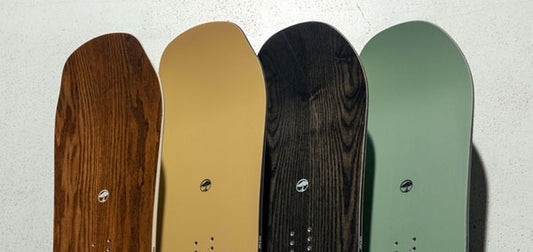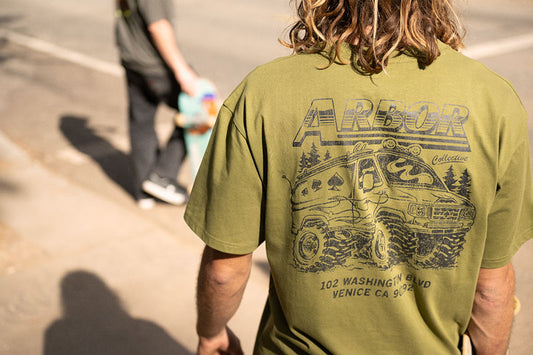All you need to learn about Wheels
Skateboard Wheels Guidebook
Skateboard Wheels
Humans invented the Wheel millennia ago, and it's still a vital tool to get you to where you want to go. But, the Skateboard Wheel has evolved over the years since it has adapted from Rollerskate parts, just like the original Skateboard Trucks.
Wheel Sizes
Skateboard Wheels come in many sizes, and are generally measured in Millimeters (mm) by their Diameter, Width, and Contact Patch.
- Diameter: The Measurement from the bottom to the top of the Wheel, also known as the height. Smaller Wheels are better for technical tricks, but are generally slower. Larger Wheels have higher roll speeds, but are heavier and make tricks more difficult.
- Width: The Measurement from the Face to the Back of the Wheel. Narrower Wheels are more maneuverable and more likely to slide, but are less stable at higher speeds. A wider Wheel provides more surface area with the ground, which makes them more stable and provide better grip.
- Contact Patch: The Measurement of the width of the Rolling Surface area that touches the ground. Some Wheels' Contact Patches come with fresh skins, meaning the surface area is shiny and smooth, like the rest of the Wheel, and naturally having more grip. Other Wheels' Contact Patches are Stone Ground, meaning the surface is sanded, and makes them easier to break in and more likely to slide right out of the box. Other Wheels' Contact Patches are Grooved, giving them a balance of grip and slip.
Wheel Surfaces
The surfaces of the Wheel are described as the Rolling Surface, Face, Back, and Lip.
- Rolling Surface: The Rolling Surface is the area of the Wheel that comes into contact with the ground while riding a Skateboard. This surface is also described as the Contact Patch.
- Face: The Face is generally the part of the Wheel that is facing outwards, away from the Rails of the Skateboard. This is usually where the Artwork of the Wheel is located.
- Back: The Back of the Wheel generally faces inwards, towards the center of the Skateboard. The Face and Back can be similar to each other, or very different, it all depends on the Wheel design and it's general purpose. Wheel Artwork can also sometimes be found on the Back.
- Lip: The Lip of the Wheel is the area of some Wheels' Face or Back, that has a flat, rounded, or beveled surface.
*Arbor Whiskey Series Revert Conical Wheel
*Arbor Signature Series Vice Round-Lipped and Summit Sharp-Lipped Wheels
Wheel Shapes
The Shape of the Wheel can dramatically vary, depending on the preferences of the rider, and can also be determined by the riding terrain. A few Shapes include Square, Round, Tablet, Radial, Conical, Square-Lipped, Sharp-Lipped, and Round-Lipped.
- Square: The Wheel Face and Rolling Surface meet at a square angle, with no roundness or beveling. The Width and Contact Patch measurements are the exact same. The Face remains flat, until it meets the Bearing Seat or Core. This shape is very stable, and hard to slide.
- Tablet: The Wheel Face and Rolling Surface blend together as a rounded edge. The Contact Patch is narrower than the Width. The Face remains flat, until it meets the Bearing Seat or Core. This shape provides a balance of stability and slip.
- Round: The Wheel Face and Rolling Surface blend together as an extremely rounded edge, similar to a full-circle. The Contact Patch is much narrower than the Width. The Face remains flat, until it meets the Bearing Seat or Core. This shape is easier to slide than a Square Wheel.
- Radial: The Wheel Face and Rolling Surface blend together as a rounded edge, and the radius can vary. The Contact Patch is narrower than the Width. The Face then continues that same or similar radius, until it meets the Bearing Seat or Core. This shape is much easier to slide than a Square Wheel.
- Conical: The Wheel Face and Rolling Surface blend together as a rounded edge, and the radius can vary. The Contact Patch is narrower than the Width. The rounded Face then comes to a sharp edge and continues with a flat surface, until it meets the Bearing Seat or Core.
- Square-Lipped: The Wheel Face and Rolling Surface meet at a square angle, with no roundness or beveling. The Width and Contact Patch measurements are generally the same. The Face remains flat, and then dips inward with varying or blended surfaces of concave, convex, or flat, until it meets the Bearing Seat or Core. The Square Lip makes the Wheel Face much less likely to flex, and more rigid. This shape is extremely stable, and generally very hard to slide.
- Sharp-Lipped: The Wheel Face and Rolling Surface meet at a square angle, with no roundness or beveling. The Width and Contact Patch measurements are generally the same. The Face then either has a small flat surface or immediately dips inward with varying or blended surfaces of concave, convex, or flat, until it meets the Bearing Seat or Core. The Sharp Lip makes the Wheel Face act as a leaf-spring and help rebound through turns. This shape is generally more stable, and harder to slide.
- Round-Lipped: The Wheel Face and Rolling Surface blend together as a rounded edge, and the radius can vary. The Contact Patch is narrower than the Width. The Face then either has a small flat surface or immediately bevel inward with varying or blended surfaces of concave, convex, or flat, until it meets the Bearing Seat or Core. The Round Lip makes the Wheel Face act as a leaf-spring and help rebound through turns. This shape is generally more maneuverable, and easier to slide.
Urethane
Originally, Skateboard Wheels were made of Steel or Clay, as they were adapted from Roller Skates. These Wheels did not perform well, as small rocks or debris would cause the Wheel to stop abruptly. After the invention of Plastic Polyurethane in 70's (*also known as Urethane), Skateboard Designers quickly adapted using Urethane. It made the Wheels more forgiving by providing dampening, which allowed the Wheels to roll on rougher surfaces, while providing faster roll speeds.
Durometer
Skateboard Wheel hardness is measured by its Durometer, also known as the A Scale (A). This Scale ranges from 75A to 100A, with 75A being the Softest, to 100A being the Hardest. A Softer Wheel is generally slower, but rides smoother on all surfaces, and provides more grip (*grippy). A Harder Wheel will usually have lower roll speeds on rough surfaces, but is more maneuverable, and easier to slide.
Rebound
Along with Durometer, wheels are rated by their Rebound, which is the measurement of how fast the Urethane absorbs and then returns the energy of a bounce. Lower Rebound would provide a stable more and feel, with Higher Rebound being more responsive and fast. (((((((Danny, help me out here a lot, please)))))))
Bearing Seat
The Bearing Seat is where the Bearings sit inside the Wheel, it holds 2 Bearings per Wheel. There is usually a ridge or channel in the middle of the Bearing Seat, seperating the 2 Bearings at a specific space apart.
Cores
Some Wheels have Cores, which act as a platform in the middle of the Wheel. Cores can increase a Wheel's rigidity, and also reduce weitght, as less Urethane is used. Cores can be made with Plastic, Fiberglass, Metal, or even a combination of things, but are generally made of Plastic. Cores are measured by their Width, Height, and Saddle. Cores can vary in size and shape, and also have different elements which can provide better performance.
(((((((Danny, help me out here a lot, please)))))))
Groovetube, Revolver, Recycled Plastic, etc...
*Check out our other Guidebooks for more info on Decks, Trucks, Bearings, and Components.














